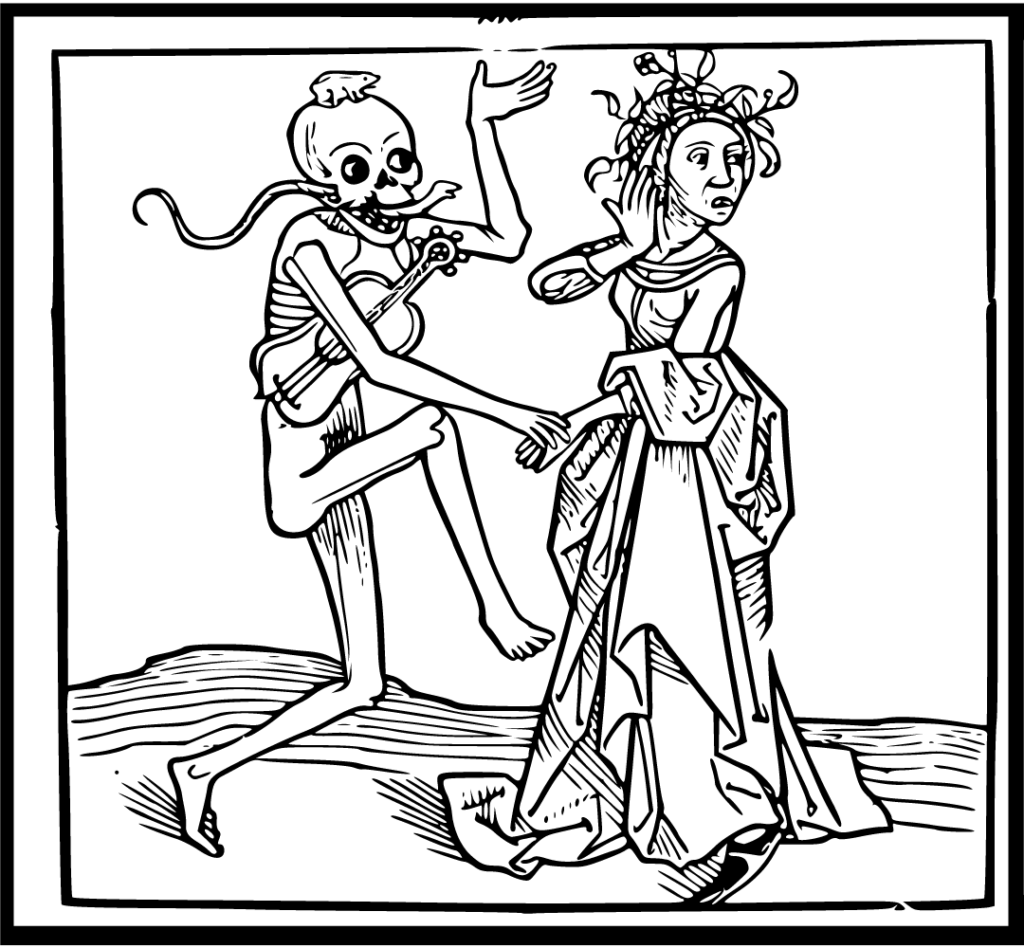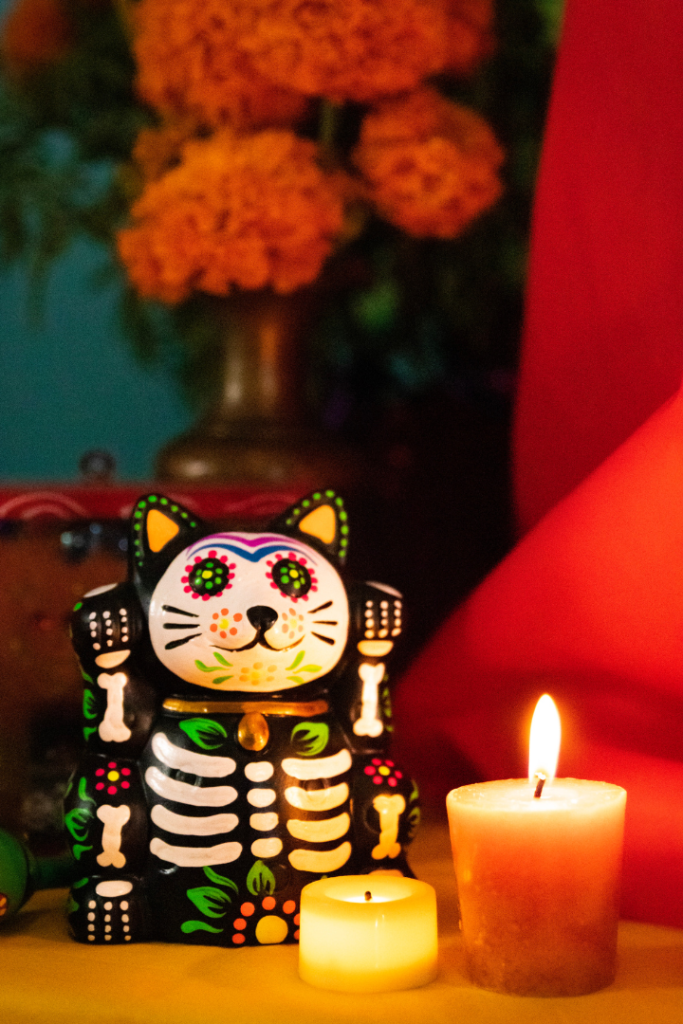I once spent the night in my own grave.
It was the first activity on a week-long vision quest. I spent the day digging my “grave”, lining it with tarps, and at sunset, settled into my hole and waited for sunrise. It started to rain, of course. Even the sky cries at funerals.
I hoped to god I wouldn’t drown.
Yes, there were bugs. And worms.
I spent the night lying in the dirt, questioning – not for the first or last time – my sanity.
At sunrise, I crawled out like a zombie in a horror flick, covered in dew and dirt. I made my way through the fog to the breakfast feast at basecamp. French toast never tasted so good.
As October morning mists drift across the water, I am taken right back to the night I spent in my grave.
The experience was meant to help me face my mortality: a Memento Mori. But I am less afraid of dying than I am of the losses I will endure before I do, as the people and animals I cherish will die. I have known grief that hobbled me for years. I fear revisiting it’s sharp edges. I fear how it tumbles my world into a strange, unrecognizable land and isolates me from others.
Fall always puts me in a melancholy mood. It signals the time of endings – the end of Summer heat, Summer joy, Summer playfulness. Sure, the trees catch fire, their leaves bursting into spectacular colors, but plants are pulled from the ground or buried to nourish next year’s crop. Bushes that once held colourful, fragrant flowers are cut back to clumps of twigs. Small trees are wrapped for protection from the deadly cold of Winter.
I am wrapped in woollen sweaters and scarves for the same purpose.
Maybe it’s because I’m settling into my fifties <gasp!>. Maybe it’s the loss we’ve collectively and personally experienced these last two years. Maybe it’s seeing age settle into the bones of my dog Charlie. Maybe it is the animal companions we have lost showing up in my dreams lately. But I am brooding in my woolen cocoon. Everything looks dead or dying. I resent the coming cold.
Hot flashes notwithstanding, I don’t think I’ll feel warm again until July.
On our walk, Charlie and I crossed paths with a racoon lumbering up the trail, fat and slow like I feel after too much apple crisp. We watched her as she waddled across the trail and disappeared into the woods. It struck me that she didn’t fear me or Charlie (granted, he was leashed). But nor did she seem to fear the coming cold.
Do all woodland creatures prepare for the Great Sleep of Winter without resistance or resentment? They spend the Summer collecting, building, burrowing, nesting. When the chilling of the air prepares their bodies for hibernation, they don’t fight it. Their nests and dens are warm, safe, and their bellies are full. I envy them.
In her article about embracing all the seasons, director of the The Gaia School of Healing Marysia Miernowska writes about Fall as an opportunity.
“We feel the pull back in, to reflect, to savor the sweetness and to prepare for another journey deeper into the mystery of silence. We are one turn around the sun wiser, it is time to integrate the experiences we gathered and descend into the fertile darkness, where once again we will meet the spark of source that heralds a new beginning.”
Rather than respecting the pull back in, I plough forward as if Fall is a personal affront, a betrayal of my beloved Summer. I snarl at people who love this season, their IG feeds filled with grinning rosy-cheeked selfies, holding their offering of pumpkin spiced lattes to the gods of the harvest.
“Bah humbug,” I mutter, stuffing my face with another bite-sized version of a chocolate bar. I do like Hallowe’en. Yes, I like the sudden abundance of bite-sized chocolate bars, but also, the skeletons, the skulls, the chaos and the horror mirror what I feel about the inevitability of death and loss.
For thousands of years, cultures the world over have had autumn rituals to reckon with the fragility of life: Day of the Dead, Samhain, Hallow’s Eve. Rather than shying away from it, these ceremonies embrace the thinning of the veil that separates life from death.
The Danse Macabre (the spooky dance) is an allegory dating back to 15th century Europe, describing the universality of death. A grim reaper leads people in a forced dance towards their grave. I mean, the bubonic plague had just swept through killing more than half the population, so they were inspired. And a little unhinged, I’m sure.

But that’s exactly how the season feels to me. Instead of listening to my body, which is aching to slow down, I fill my calendar with tasks, fill my belly with Hallowe’en candy and remain in constant motion, like a dangling marionette in a morbid dance led by invisible strings.
How do I clip those strings and stop running? How do I make peace with the inevitability of death and loss? Will I ever learn to love pumpkin spiced lattes?
I’ve always been attracted to The Day of the Dead, a multi-day holiday with Mexican and Aztec roots. Family and friends spend the night at the gravesite of loved ones who have died. They tell stories, relive memories, play joyful music and eat the deceased’s favorite foods. I love the juxtaposition of celebration and grief.
When Death shows up with marionette strings, there’s nobody home. They’re in the cemetery, dancing, eating, laughing, crying. I imagine the devouring of sweet breads, the dancing and laughter as a defiance. “Yes, we know you’re ever present. We know you will always come for us and those we love, but while we still live, while we’re here, we will savour life in all it’s loud, colourful and savory facets.”
Author Ivana Martinez writes “Though some of the holidays’ practices may seem spooky, It’s a cheerful way of coexisting with loss. Day of the Dead helps my family—and countless other Mexican families—cope with the sadness, denial, and anger that comes with losing someone. It’s remembering that happiness can exist amid sorrow; it allows us to relieve the sadness in a way that benefits the entire family and makes it feel complete again.”

Cheerfully coexisting with loss.
That’s what these rites are meant to help us do. They conjure our fears of death so they can be defied with a burst of life. They meet sorrow with sweetness and community. We remember and celebrate those we lost. These rituals help us integrate that being alive includes loss.
Consciously taking time to grieve and honour our losses on a yearly basis is a kind of resilience training. It teaches us to take the long view and keep things in perspective. It informs our choices so we fill our time left with what truly matters to us. Because we take nothing for granted, we learn to look beyond what a moment owes us to what it gives us.
And when loss happens – because it will – and we find ourselves in the land of grief, it’s familiar. It’s one we’ve visited before. Our skills are honed. We know it will not undo us. We know we are not alone. We know we are not broken or crazy. We know we will prevail. Because we have crawled out of our grave and danced in the sky’s tears.
Keys:
- Create your own Day of the Dead ritual. Research your heritage – are there rites and traditions you can explore that connect you to your ancestors?
- Relive your most precious moments from the year, and from those you lost. Reflect what these experiences taught you, how these loved ones changed you. This is sometimes easier to do in community or with close friends. Especially when grief is sharp and fresh.
- Speak the names of those lost out loud and thank them for their legacy.
- Schedule a time to be in community with others in mourning. Spend time comforting and being comforted. Both are healing.
- Acknowledge too that you still live – feast on the harvest the growing season brought. Make your favorite dishes. Learn of their origins.
- Savour those you love. Let them know how they enrich your life.
Related
[mailerlite_form form_id=1]